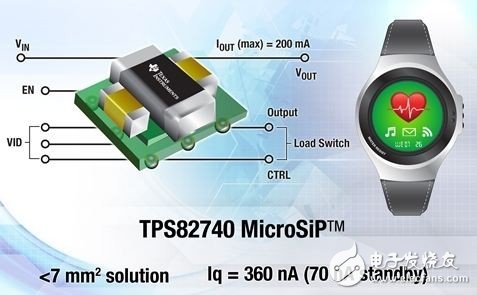Are you looking forward to developing wearable devices like watches, oximeters or blood pressure monitors? The small size and advanced features required for smart watches present two basic challenges for system designers: How do you fit everything you need into a defined package? How do you power your device?

There are three solutions for ultra-low power operation in wearable electronics:
1. Run as much as possible in standby mode
The key to achieving long battery life is to minimize current consumption during operation by reducing unnecessary system activity. This means that in addition to turning off certain functions, it also runs in the sleep or standby mode of the microcontroller and the power save mode of the power supply. For example, when the user does not look at his (or her) watch, the display of the watch is turned off. Or when is SimpleLink? Bluetooth? When the low-power CC2541 wireless microcontroller (MCU) can run only through the sleep timer instead of timer 1, the supply current is reduced from approximately 90μA to only 0.6μA – the power-saving rate exceeds 99%! In addition, any background tasks must be driven by interrupts within the code. This way, the microcontroller can run in sleep mode as much as possible, only when it interrupts the command.
2. Minimize current consumption in standby mode
A key technology driver is to reduce the current drawn in these standby modes. For example, using EnergyTrace++? The technology's MSP430F59xx (FRAM) microcontroller consumes only 450nA of current in standby mode, thanks to its extremely low-leakage FRAM memory. If you use the TPS82740A to power the microcontroller, the current drawn from a single-cell Li-Ion battery is only about 750nA, even if the microcontroller is slightly leaking when you supply power. In this case, the 360nA quiescent current (IQ) and the DCS-Control topology combine to achieve such low standby power consumption. If your current consumption is really low, you must have a load switch to disconnect the subsystems that are turned off (depending on their supply voltage) to prevent them from leaking current from the system.
3. Integrate to save valuable printed circuit board (PCB) space
Since you have reduced power consumption to a reasonable level, the battery does not need to be recharged every day. The second problem is the space problem – where do you plan to put all the devices (microcontrollers, sensors, power supplies, batteries, etc.)? For this challenge, the integration method can help you a lot. The TPS82740A is a MicroSIP device that integrates all the necessary passive components and a load switch! This is less than 75% smaller than the discrete TPS62740 type implementation with the same ultra low power performance (optimized). In addition, the MSP430F59xx integrates features such as temperature sensor functionality, differential input analog-to-digital converter capability, 8-to-1 multiplexer LCD display driver capability, and 256-bit encryption. Just add a battery and some other system-specific sensors, and you're basically done!
Run in standby mode, minimize current consumption in standby mode, and integrate to save board space – these three methods will make your next wearable design a success.
Christmas Mini Light String is waterproof and durable. Can be used in any season and many applications such as wedding, party, garden etc. We have different wire model and Replacement Bulb type to choose.
Decorative string lights are not just for holidays anymore . Instantly transform indoor and outdoor spaces with a wide selection of covers and finishes that match current trends and personal tastes and expressions.
Celebrate any season ,event or inspired whim with a charming new set of outdoor string lights!
Christmas Mini Light String
Mini Light String,Mini String Lights,Mini Led Christmas Lights,Led Mini String Lights
DONGGUAN JIANXING LIGHTING ELECTRIC APPLIANCES CO., LTD , https://www.rslightstring.com